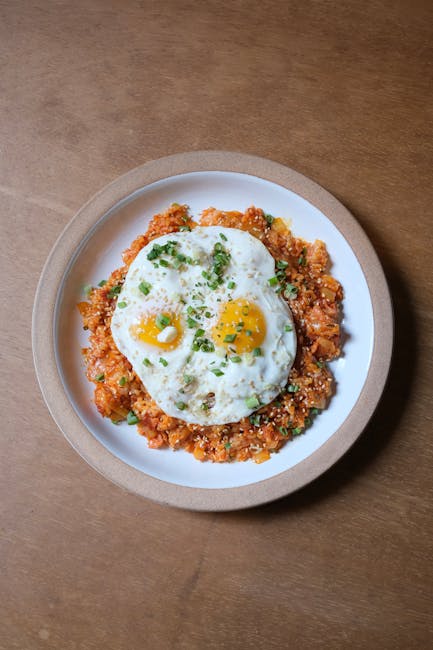Introduction
Kimchi fried rice, or Kimchi Bokkeumbap (김치볶음밥), is a flavor-packed and incredibly satisfying Korean dish. It’s a fantastic way to use up leftover rice and that delicious, fermented kimchi that’s been sitting in your fridge. This dish is not only quick and easy to make, but it’s also bursting with umami, spice, and a delightful tangy flavor. Whether you’re a seasoned cook or just starting out, kimchi fried rice is a must-try recipe that will quickly become a weeknight favorite.
Making the Perfect Kimchi Fried Rice
Choosing the Right Ingredients
The quality of your ingredients will significantly impact the final taste of your kimchi fried rice. Here’s what to consider:
- Kimchi: Use well-fermented, slightly sour kimchi for the best flavor. Older kimchi is ideal as its deeper, more complex flavor profile will shine through.
- Rice: Day-old cooked rice is key! Freshly cooked rice is too moist and will result in soggy fried rice. Leftover rice, dried out slightly in the fridge, works perfectly.
- Protein: Options abound! Pork belly, spam, bacon, beef, chicken, tofu, or even canned tuna all work well. Choose your favorite or use what you have on hand.
- Other Vegetables: Onions and scallions are classic additions. You can also add carrots, mushrooms, zucchini, or any other vegetables you enjoy.
- Gochujang (Korean Chili Paste): This adds depth, spice, and a touch of sweetness. Adjust the amount to your spice preference.
- Gochugaru (Korean Chili Flakes): For an extra kick and vibrant color.
- Sesame Oil: Essential for that nutty, aromatic flavor that defines Korean cuisine.
- Soy Sauce: Adds savory depth and umami.
- Egg: A fried egg on top is practically mandatory! The runny yolk creates a creamy sauce that complements the spicy rice perfectly.
Step-by-Step Recipe
Follow these steps for delicious kimchi fried rice:
- Prepare the Kimchi: Chop the kimchi into bite-sized pieces. Reserve some kimchi juice; it adds great flavor!
- Cook the Protein (if using): Dice your chosen protein and cook it in a pan until browned. Remove from the pan and set aside.
- Sauté the Vegetables: Add the onion and other vegetables to the pan and sauté until softened.
- Add the Kimchi: Add the chopped kimchi and kimchi juice to the pan and cook for a few minutes, allowing the flavors to meld.
- Incorporate the Rice: Add the cooked rice to the pan, breaking it up with a spatula. Make sure everything is well combined.
- Season the Rice: Add gochujang, gochugaru, sesame oil, and soy sauce to the pan. Stir well to distribute the seasonings evenly. Taste and adjust seasonings as needed.
- Add Back the Protein: Add the cooked protein back into the pan and stir to combine.
- Fry an Egg: While the rice is cooking, fry an egg in a separate pan.
- Serve: Serve the kimchi fried rice hot, topped with a fried egg, a sprinkle of sesame seeds, and chopped scallions.
Tips and Tricks for Kimchi Fried Rice Success
- Don’t Overcrowd the Pan: If you’re making a large batch, cook the rice in batches to ensure even cooking and browning.
- Adjust the Spice Level: Start with a small amount of gochujang and gochugaru and add more to taste.
- Use High Heat: Cooking over high heat will help create a slightly crispy texture on the rice.
- Don’t Skip the Sesame Oil: Sesame oil is crucial for the authentic Korean flavor.
- Experiment with Toppings: Try adding seaweed flakes (kim), a drizzle of mayonnaise, or even a sprinkle of shredded cheese.
Conclusion
Kimchi fried rice is a versatile and flavorful dish that’s perfect for a quick and easy meal. With a few simple ingredients and a little bit of practice, you can create a restaurant-quality kimchi fried rice at home. So, gather your ingredients, fire up your stove, and get ready to enjoy a delicious and satisfying Korean classic!
